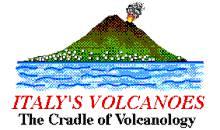 |
|
All
photos on this page were taken by Giuseppe Scarpinati
About
six months after the end of the April-June 1971 eruption, vigorous
explosive activity resumed in the Voragine. This photo, taken on
17 December 1971, shows dense ash plumes being emitted from the
crater. The view is from south.
|
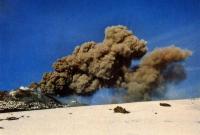 |
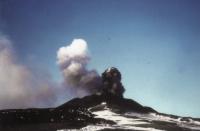 |
Two
successive views of an episode of ash emission from the Voragine
on 18 December 1971, seen from the upper southern flank. Height
of plume in right image is about 800-1000 m.
|
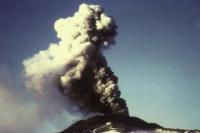 |
|
Explosive
activity at the Voragine causing ash emissions continues into early
1972. The main summit cone is seen in this photo taken on 5 January
1972, with a dense plume of ash rising from the Voragine, and the
scoria cones formed during the first stage of the 1971 eruption
are visible at the base of the main summit cone.
|
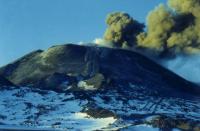 |
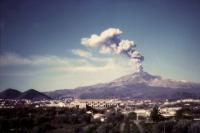 |
Etna
is seen here emitting an ash plume about 1500-2000 m high in January
1972. This photo is a panoramic view from the area of Mascalucia,
a town located at 300-400 m elevation on the S flank of the volcano.
The conspicuous twin-peaked cone at left is Monti Rossi, the main
crater of the 1669 flank eruption, source of a voluminous lava flow
that reached the sea south of Catania and destroyed part of the
city.
|
|
A
suggestive night view of eruptive activity from two vents within
the Voragine in August 1973. Activity showed a remarkable increase
in that period and led to the rapid filling of the crater, so that
its depth was only about 100 m at the time this photo was taken.
In the nearby Bocca Nuova, the crater floor had risen even higher.
During the same period, intense seismic activity occurred at the
"Timpe" fault system on the eastern flank, causing heightened
apprehension, but the seismicity was probably unrelated to the volcanic
activity at the summit. The eruptive activity underwent a further
increase in early November 1973, when vigorous lava fountains occurred
at the Voragine, and the crater rim was buried under several meters
of agglutinate.
|
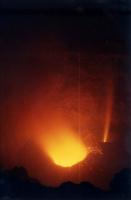 |
Continue
with
THE 1974 W FLANK ERUPTION
|
